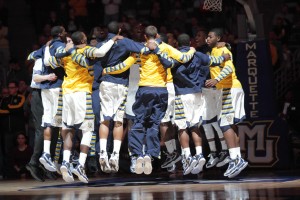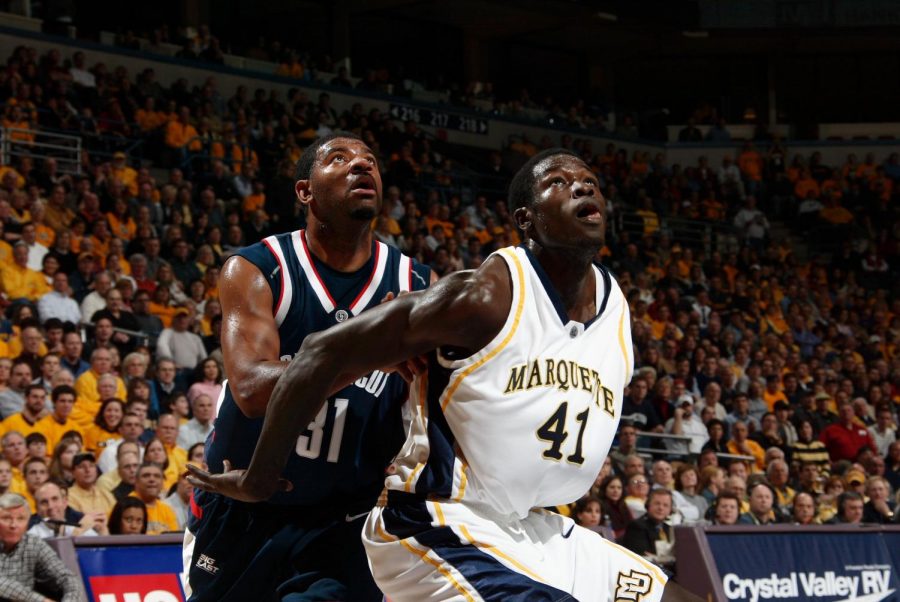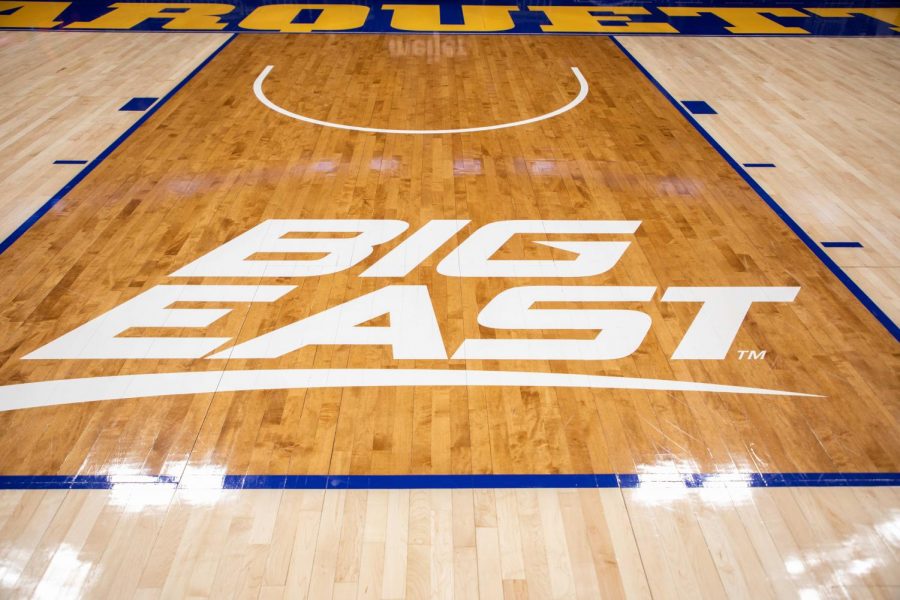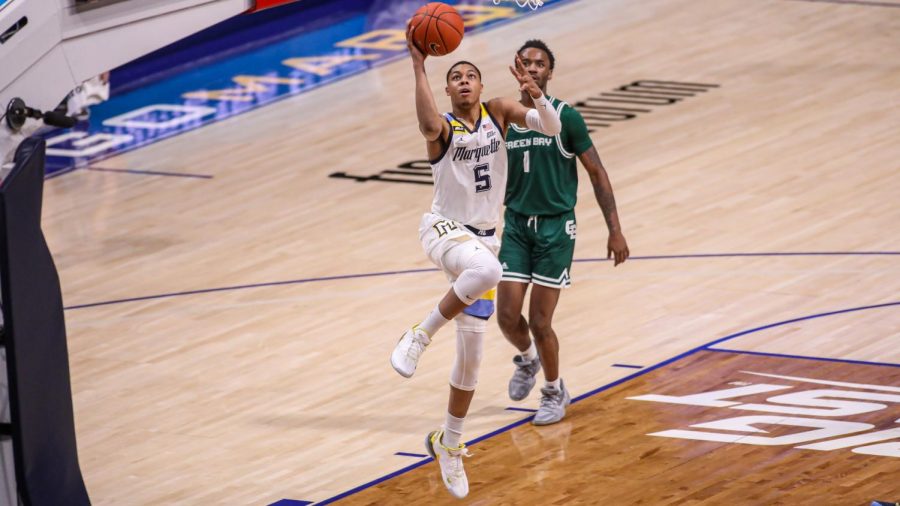 Collegiate athletics, despite what the NCAA has constantly tried to quell, is in fact a business. Athletic departments, a major recruiting tool for both athletes and students for a college, claim a non-profit, but rake in millions of dollars. ESPN’s sports business reporter Darren Rovell reported that 28 of the 68 NCAA tournament teams this year either broke even or lost money during the basketball season. In other words, 40 of 68 teams turned a profit this basketball season.
Collegiate athletics, despite what the NCAA has constantly tried to quell, is in fact a business. Athletic departments, a major recruiting tool for both athletes and students for a college, claim a non-profit, but rake in millions of dollars. ESPN’s sports business reporter Darren Rovell reported that 28 of the 68 NCAA tournament teams this year either broke even or lost money during the basketball season. In other words, 40 of 68 teams turned a profit this basketball season.
Money is obviously an important factor when athletic departments make a decision. And the ever-growing profitability of men’s football and basketball in the NCAA created a major shift in college athletics.
In its second year in the “new” Big East, Marquette has seen its stock rise in collegiate basketball. As a whole, the conference still hasn’t realized the full impact of the Big East split. On the field/court, the Big East still compares itself to the American Athletic Conference, where schools of the old conference remain. But was becoming part of the “new” Big East the right move for the Golden Eagles?
The Split
The fracturing within the Big East really started back in 2005, which is coincidentally when Marquette entered the Big East.
The Big East, which was founded as a basketball-only conference, was having trouble with its football schools, many of which were admitted into the conference in fear of losing those basketball schools that also had a good football team. In 1991, Rutgers, Miami (Fla.), Temple, Virginia Tech and West Virginia were all added into the conference to help fund the Big East and keep the likes of Georgetown, Villanova, Pittsburgh and Boston College, who had football teams, happy with the added competition.
In 2005, citing lack of football competitiveness, Virginia Tech, Boston College and Miami all bolted to the Atlantic Coast Conference. In response, the Big East added Louisville, Cincinnati, South Florida, Marquette and DePaul all from Conference USA.
The conference had five years of success, until Syracuse and Pittsburgh announced they would also be heading to the ACC, which signaled the beginning of the end for the “old” Big East.
In order to try and regain teams, the Big East sent an offer to Texas Christian, which accepted, then turned down the offer to join the Big 12. In 2011, West Virginia also left the Big East for the Big 12, which prompted the conference to add Boise State and San Diego State for football only, and Central Florida, Southern Methodist and Houston for all sports.
The domino effect continued as, in early 2012, Memphis and Temple were added for all sports and Navy was announced as a football only member of the conference. This led Notre Dame to leave for the ACC and Rutgers to head to the Big Ten, which was announced late in 2012. To try and accommodate the schools lost, the Big East added Eastern Carolina for football only and Tulane as an all sports member. A day after the Tulane announcement, Louisville announced it too would be heading to the ACC.
Losing Louisville was the final straw for the basketball members of the conference. Since 2011, the Big East had lost Pittsburgh, Syracuse, West Virginia, Rutgers, Notre Dame and Louisville. Replacing those schools were Central Florida, Southern Methodist, Houston, Memphis, Temple and Tulane.
With so much instability in the conference, along with replacing storied programs with questionable mid-majors, the seven non-football schools (DePaul, Georgetown, Marquette, Providence, St. John’s, Seton Hall and Villanova) met and announced they would be splitting from the conference, taking the Big East name with them.
Big East commissioner Val Ackerman told USA Today in 2013 that breaking away from the American and football itself had some risks, but would benefit the Big East in the long run.
“I believe the Big East presidents really believe it can be done — otherwise, they wouldn’t have made this move to pull away from what’s now the American and base their business on a sport other than football,” Ackerman said. “They are not going to get football revenues as a result of that, but they’re also not going to have football costs or the football distractions.”
The “Catholic Seven” as they were deemed, added Butler, Creighton and Xavier to become the “new” Big East, while Cincinnati, Connecticut and South Florida were stuck and forced to stay with the new conference, called the American Athletic Conference.
Revenue Drivers
The Big East, because of its new conference stature, had to come up with a new conference TV contract and decided to sign with Fox Sports, with Fox Sports 1 becoming the primary channel for all sports. Fox Sports 1 has featured men’s and women’s basketball, while also showing conference championship games for men’s and women’s soccer and a few other games of other sports as well.
The TV contract signed with Fox Sports was a 12-year deal worth $500 million. Meanwhile, the American has a football and basketball contract with ESPN for $126 million, while also having a contract with CBS for $54 million, according to a Kristi Dosh report for ESPN in 2013.
Much of the Big East’s Fox Sports TV contract hasn’t kicked in yet, but the new Big East has not suffered because of it. Using data from the 2013-14 basketball season, Forbes released its 20 most valuable schools. Former Big East schools Louisville (No. 1, valued at $38.3 million) and Syracuse (No. 6, valued at $26.8 million) were some of the most valued schools. But Marquette came in at No. 15, valued at $12.2 million. The No. 15 ranking is the highest the school has ever been and the first Big East or American school on the list. Xavier came in at No. 18, valued at $11.2 million, while collegiate powerhouses Villanova and Connecticut failed to make the list.
Being one of the 20 most valuable basketball programs doesn’t come without a hefty price tag, though. Marquette also ranks in the top 30 of largest budgets for the men’s basketball team, as reported by the Milwaukee Business Journal. Marquette spent $10,522,823 on its basketball program this season, while only managing 13 wins, the fewest among the top 30. Marquette spends the eighth most on basketball in the entire country. Other Big East schools in the top 30 are Georgetown (ninth with $10,270,598) and St. John’s (21st with $8,254,545). Villanova barely missed the cut, spending $7,304,201, which ranked 32nd. Two American teams also made the list, as Memphis ranked 15th, spending $9,475,690, and Connecticut spent $8,282,680, which ranked 20th.
But that’s just men’s basketball. The Big East features 22 total sports; 10 men’s sports and 12 women’s sports.
According to the Department of Education, every Big East school has the exact same dollar amount for expenses and revenues. St. John’s spends and brings in the most money for the athletic department with $37,653,386 in total expenses and revenues. The school spending and making the least is Xavier, totaling $16,552,274, just 44 percent of what St. John’s spends and makes on athletics. Marquette ranked fourth in the Big East on spending and revenues, totaling $29,721,972.
However, the split between men’s and women’s spending and revenues is not evenly split. While St. John’s makes and spends the most money, it only ranks fourth in men’s spending and third in women’s spending. The leading spender in men’s and women’s sports is Villanova with $17,595,315 and $9,269,359, respectively. The leading school in terms of revenues for men’s was Marquette with $21,767,983, while Villanova makes the most for women’s sports with $9,269,959. Marquette ranked fifth in women’s revenues with $7,870,342.
There is also an aspect of spending and earning that is not allocated by gender or sport, but the Department of Education does not offer an explanation of what that money is because all of the Big East schools are private and therefore that is not public record. St. John’s leads in that category with $15,048,608 of expenses and revenues in that category. Xavier has the least non-allocated by gender/sport expenses with just $3,682,396, while Marquette has the lowest non-allocated by gender/sport revenues with just $83,647. Marquette is ranked fifth in non-allocated by gender/sport spending with $6,801,282.
Another major aspect of an athletic department is how much it spends on recruiting. In the Big East, Marquette spends the most on recruiting by a long shot with $1,779,737 in total recruiting costs. Marquette is the only Big East school to crack seven figures. Georgetown ranks second in total recruiting costs, spending $666,516 and Butler spends the least with just $282,121 in recruiting expenses.
For men’s sports, Marquette spends the most, with costs totaling $1,612,467. Second in recruiting expenses for men’s sports is Georgetown, which spends $492,535. Last in recruiting costs for men’s sports is Butler with $165,355. Women’s sports sees drastically smaller recruiting costs; Xavier leads the way with $233,102. Creighton spends the least on recruiting costs for women’s sports, with just $93,625. Marquette spends the seventh most on recruiting for women’s sports, spending $167,270.
Competitive Success
A major reason why the “Catholic Seven” left the old Big East was because the talent level of the schools coming into the conference wasn’t at the level of the schools that were leaving the conference. But how has the new Big East compared to the American? Pretty well, actually.
Basketball is the major sport for the Big East and this year the Big East saw much better success than the American. The Big East sent six teams to the big dance, while the American just sent two. But the American did send three teams to the NIT, while the Big East didn’t have any team get a bid. On the women’s side, the American sent three teams to the March Madness bracket, while the Big East only had two teams. In the WNIT, the Big East and American both received three bids.
Through the first weekend of the NCAA Tournament, Xavier was the only one of the six Big East bids to make it to the Sweet 16. No. 1 seed Villanova was projected to make it to the Final Four, but was upset by North Carolina State in the second round. The American lost both bids by the second round.
Big East commissioner Val Ackerman said basketball has been the biggest success in the Big East, which won’t change anytime soon.
“We’ve got strength elsewhere as well, but basketball is clearly the lead dog and I do think we’re going to be just fine, and then some,” Ackerman said in a press conference before the Big East tournament.
Marquette coach Steve Wojciechowski praised the new league as well, telling the New York Times the league is exactly as how he pictured it would be after his first season in the conference.
“The Big East is what I thought it would be,” Wojciechowski said. “You have a lot of very good, experienced players, obviously outstanding coaches, and tremendous home courts. I’d put our league against any league in the country.”
But when strictly looking at the Big East, the money spent for each athletic department doesn’t necessarily translate to athletic success.
The best schools in the conference so far have been Villanova and DePaul. Both schools have six combined regular season and tournament championships, and Marquette is close behind with five. DePaul dominates women’s sports with all six championships coming from that side, while five of Villanova’s six championships come on the men’s side. For Marquette, the only men’s title is in the 2013 men’s soccer tournament championship.
In terms of money, Villanova spends the second-most on sports, Marquette fourth and DePaul sixth. St. John’s, who spends the most money on athletics, has exactly zero conference regular season or tournament championships. Conversely, Xavier, which spends the least amount of money on athletics, has a tournament championship in baseball.
Part of the success could come down to recruiting and how much a school pays for recruiting. Marquette spends the most and has five titles. DePaul is fourth and has six titles. But Villanova is eighth in recruiting expenses and is tied with DePaul for the most.
While regular season and conference tournament banners are great for schools, it isn’t the best way for departments to compare themselves to one another. Taking a look at the final rankings tells how strong a conference is as a whole compared to others around the country.
For the sake of this article, the only sports compared will be those where both the American and Big East have full participation from all of its members. Those sports are men’s basketball, women’s basketball, women’s cross country, women’s tennis and volleyball.
Men’s and women’s basketball are the most important sports in the Big East and while it isn’t football for the American, it’s still extremely important. The Big East had three teams in the final top-25 rankings, including Villanova at No. 2. Meanwhile, the American had just one, Southern Methodist. In women’s basketball, the Big East didn’t have a single team in the top-25, while the American had two, Connecticut and South Florida.
Volleyball, while not as important as basketball, is still a ticketed sport for many of the Big East schools, Marquette included. In the final top-25 for women’s volleyball, neither conference had a team in the top-25 or even receiving votes. In women’s cross country, the only Big East school in the top-30 was Georgetown, which was ranked No. 2. The American didn’t have a single school in the top-30. And for women’s tennis, which is still in season, neither conference had a team in the most recent top-25 rankings.
Men’s soccer and women’s soccer is highly important to the Big East schools, which is why all members have a team. However, in the American, Houston, East Carolina and Tulane don’t have a men’s team, with Tulane also not having a women’s team to boot. But in those sports, the Big East had three teams in the top-25 in men’s and two in the women’s top-25. In both men’s and women’s soccer, the American does not feature a single team in the top-25.
There is one sport, however, where the Big East and American directly compete with each other: women’s lacrosse. Three members of the AAC – Cincinnati, Connecticut and Temple – compete in the Big East for the sport. At time of publishing, Temple leads the conference with an 8-2 record, with Connecticut tied for third with Georgetown and Villanova at 6-4. Cincinnati is the worst team in the conference with a 2-9 record.
Moving Forward
The Big East spends and makes a lot of money and will continue to rake in millions of dollars from the athletic departments. But the future raises some question for the conference.
The deal with Fox Sports 1 hasn’t necessarily worked out the way the conference has hoped. Paint Touches wrote an article about Fox Sports 1 viewership for Big East men’s basketball games and it indicated that viewership was not very strong. The Big East had a lower viewership than it did last season, with an average of 100,454 viewers for a game. Last season, the average viewership was 109,491. Those numbers are not what either the Big East or Fox Sports was thinking when the original contract was signed. The dispute between AT&T and Fox Sports may have had something to do with those lower ratings, but the conference needs to have better viewership in the coming years for more financial stability.
Ackerman isn’t worried about the viewership though, likening the numbers to when the Big East first started on ESPN.
“Fox has been a great partner,” Ackerman said. “As equity develops in their dial position, we think viewers will continue to find them, which is great for our schools and our coaches and our student-athletes.”
Another question revolves around expansion; if the conference will field more sports. As it stands, only both basketballs, both soccers, and women’s cross-country, tennis and volleyball field all 10 Big East members. The majority of sports features strictly Big East members, but not all compete. For example, Marquette does not compete in men’s baseball, but Georgetown does.
Lacrosse proves to be a very interesting aspect for the conference, as both men’s and women’s lacrosse features associate members of the conference. Denver is an example, as it competes in the Big East for lacrosse, but in the Summit League in all other sports. Women’s lacrosse features five different schools competing in the Big East for women’s lacrosse, but in other conferences for all other sports. Florida and Vanderbilt of the Southeastern Conference join Connecticut, Temple and Cincinnati of the American in the Big East.
Having the Big East schools field more teams to fill out more sports, or bringing in two or more schools as full-time members of the conference could also bring in more money for the respective universities. With as much money as some schools bring in with revenues, adding more schools could increase those numbers.
As good as the Big East has been on and off the field, bringing in the right kind of schools is paramount; it’s the exact reason why the “new” Big East is the way it is now. But that may not be necessary, as the conference is succeeding with how much money all the schools are bringing in.
The new Big East has taken a hit from its split with the American, which is seen in its TV numbers and revenue. But the success of its teams, specifically in men’s basketball, can push the conference back to its national prominence – without the help of football.











